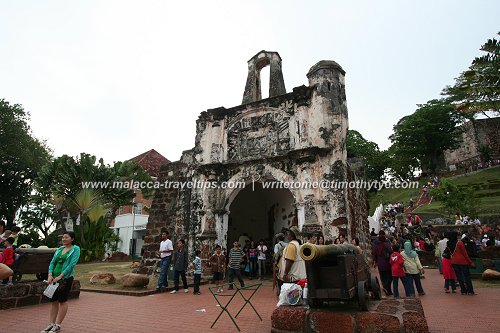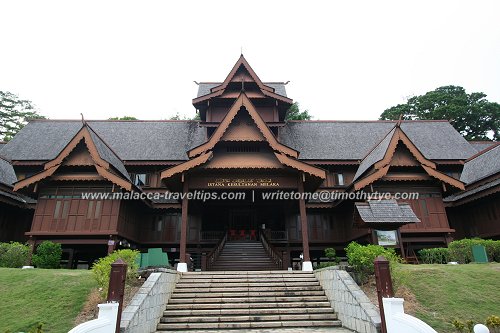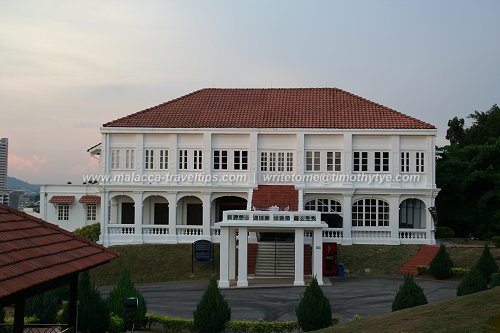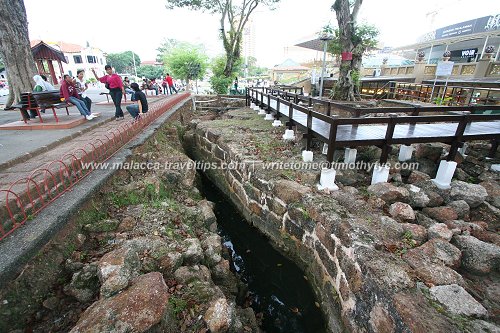 History of Malacca
History of Malacca
[an error occurred while processing this directive]
The history of Malacca stretches from the start of the 15th century. As it is known today, the history comprises of oral documentation mixed with legends and accounts gathered from various sources, the most significant being a chronical called Sejarah Melayu, or Malay Annals. As scholars began to piece together the history with seriousness, there has been numerous instances where the age-old belief have to be debunked as widely held fallacies. Some questions remain unanswered, like who is Hang Li Poh who married the Malacca sultan. Modern scholars believe that the princess does not exist - not by birth anyway. In a similar vein, there is no such thing as Hang Li Poh's well either. Although the well exists, scholars and historians are sceptical as to whether there was a connection between it and the so-called princess. There is also much speculation over the role of Admiral Cheng Ho (Zheng He) and Bukit Cina, the belief being that the admiral's position in Malacca had been over amplified.A gulf of two hundred years separates Admiral Cheng Ho's arrival in Malacca and the earliest tombstone found on the hill, so some historians are today questioning whether there's more myth than matter associating Cheng Ho and Bukit Cina. But the biggest inaccuracy is reserved for the most famous building in Malacca: the one which many school children in Malaysia used to call A Famosa. The truth is, it is not A Famosa. The real A Famosa has long been demolished, and even then, the real A Famosa isn't even on the same spot as the pile of rubble that we call A Famosa today. The more correct name for it is Porta de Santiago. It is heartening to note that the museums in Malacca and the latest tourist brochures are finally moving towards correctly labeling Porta de Santiago.
 Porta de Santiago (1 May 2009)
Porta de Santiago (1 May 2009)
The Beginning of Malacca
To tell the story of Malacca, let's go back in time by six hundred years, to around 1400AD. Before the British, the Dutch, the Portuguese, before even the start of the first Malacca sultanate. During that earliest of early time, there were two major kingdoms: the Buddhist Siamese Kingdom with its capital in Ayutthaya, and the Hindu Majapahit Empire in Java. Sandwiched in between these two major powers was the Kingdom of Srivijaya, with its capital centred on Palembang. However, the Srivijaya kingdom was already in decline, with frequent attacks from the Majapahit empire further hastening its demise.Parameswara arrives
However, Malacca has reason to be thankful to the Srivijaya Kingdom, for from there came Parameswara. (Parameswara is not his real name, but rather a title for him, as a royal blood.) This Hindu prince from Palembang is credited as the founder of the Malacca Sultanate. His departure from Sumatra has been a little bit less than glorious, though. A bit of the rebellous type, he was expelled from his own kingdom, after which he settled down in Temasek (that's the old name for Singapore). However, his stay in Temasek was short. Before long he was once again a fugitive, having gotten in trouble for killing the Temasek ruler.(At this may, let me digress from my Malacca story telling to mention what historians and scholars in Singapore have dug up. Over there, they have a different account of what happened to Parameswara. The belief is that Parameswara died in Singapore and was buried there. I have even visited the grave in Singapore that is believed to belong to him. I will write about it, and put it on the AsiaExplorers website in due course.)
Back to our Malacca story telling, Parameswara fled north, stopping on his way in Muar. Further north, he arrived at a river bank where a famous incident took place: a little mousedeer intimidated his hunting dogs, so much so that the dogs fell into the river. In case you are wondering why he would have dogs, Parameswara was, as with most Malays at that time, a Hindu. Anyway, the fugitive prince was so impressed by the mousedeer that he decided to settle down at the place, which he called Melaka, after the Melaka tree which he saw in the vicinity. The whole incident took place around 1402AD.
 Replica of the Palace of the Sultan of Malacca (1 May 2009)
Replica of the Palace of the Sultan of Malacca (1 May 2009)
The Malacca Sultanate
According to my research, I believe that when the armada of the illustrious Muslim eunuch Admiral Cheng Ho (also known as Zheng He and by his personal names Ma He and Ma Sanbao) passed through Malacca in 1409, it was Parameswara who met him. I further believe that Cheng Ho brought Parameswara back to China where Parameswara presented Malacca as a vassal state of China, and that the Emperor of China, Yung Li, appointed him ruler, or Sultan, of Malacca.There is every reason for Malacca to seek the protection of China. As I've mentioned earlier, the Srivijaya Kingdom and by extension, Malacca, is sandwiched between the two regional powers of Siam and Majapahit. Parameswara would have understood early on that Malacca is sitting smack on the crossroad of Asia, with ships converging from as far away as Arabia and China. This also benefitted China, which had been at war with Siam over control over the straits and was only too pleased to have Malacca presenting itself into its control.
The Sultanate lasts for a mere 111 years, until the arrival of the Portuguese in 1511, and yet it left an indelible mark on the Malay psyche, and beyond that, the present sultans of the different Malay states can trace their roots back to Parameswara. There were all together 8 Sultans that reigned in Malacca, and they are:
1403 : Raja Iskandar Shah (that's Parameswara, after he converted to Islam) 1414 : Megat Iskandar Shah (Parameswara's son) 1424 : Raja Tengah @ Sri Maharaja @ Muhammad Shah (Megat Iskandar Shah's son) 1445 : Raja Ibrahim @ Sultan Abu Syahid (Muhammad Shah's youngest son) - murdered 1446 : Raja Kassim @ Sultan Muzaffar Shah (Raja Ibrahim's older half brother) 1459 : Raja Abdullah @ Sultan Mansur Shah (Sultan Muzaffar Shah's son) 1477 : Raja Hassan @ Sultan Alauddin Riayat Shah (Sultan Mansur Shah's son) - died mysteriously 1488 : Sultan Mahmud Shah (Sultan Alauddin's younger son, half brother to the rightful heir)
 Governor's Museum (1 May 2009)
Governor's Museum (1 May 2009)
The Princess Hang Li Poh
The golden years of the Malacca Sultanate would be during the reign of Sultan Muzaffar Shah and Sultan Mansur Shah, when the Malacca empire expanded to cover much of the peninsula as well as some parts of Sumatra. It was either Muzaffar Shah or Mansur Shah that married the so-called Princess Hang Li Poh. Latest research however has thrown some doubts as to the existence of this princess. While there was a Malacca sultan who married a Chinese maiden, she was probably not a princess by birth. Unless she underwent a name change, and her maiden name unrecorded, it is improbable that there would be a Hang Li Poh being the princess to a China emperor. Note that the emperors of China are all surnamed Zhu (Choo), so there is no possibility that an offspring would be surnamed Hang. The "Hang" might well be a title given to her, similar to Hang Tuah, Hang Jebat, and the rest of the hulubalangs.Islamization of Malacca
You would notice that the early sultans of Malacca are Hindu. They would change their name when they converted. Parameswara became Raja Iskandar Shah. He also started the trend of adding the Persian title of "Shah" to his name, denoting ruler. However, his children are not Muslims by default. Rather, they were Hindus by default. Raja Ibrahim, for instance, did not convert to Islam, preferring to take on a Hindu title of Sri Parameswara Dewa Shah. However, his reign was a mere seventeen months. A stab in the back did him off.While it is easy to assume that the Arabs introduced Islam to Malacca, in reality Islam arrived in Malacca by way of India. It was the same people who earlier on brought Hinduism that introduced Islam to Malacca - the people of the Indian subcontinent - only that, while the Hindu culture came with the traders from the Coromandel coast, Islam came with those of Gujerat and Bengal. But why embrace Islam?
The Indian Muslim traders were prosperous and influential. Converting into Islam offered a financially conducive environment to do business with them. Also, the Indian Muslims expected mosques and suraus where they can practise their religion. The first converts to Islam were the aristocratic class. Once the Sultans and other rulers converted, the faith immediately found acceptance amongst the general population of Malacca. At varying degree, the Indian Muslims were to play an influential role throughout the Malacca Sultanate, with many sultans taking on wives who were Indian Muslims.
The Beginning of the End
When the younger son of Sultan Alauddin Shah was chosen to reign instead of the rightful heir, it spelled an erosion to the power of the Sultanate. Sultan Mahmud Shah turned out to be a cruel, arrogant, and fickle tyrant. The Malays at that time was also divided, and the Sultan was also very much under the influence of the powerful Indian Muslim merchants of Gujerat.The Portuguese arrived in Malacca in 1509, under Diego Lopes de Sequeira. Afraid that the Portuguese would be a threat to their trade monopoly, the Indian Muslim merchants had persuaded the Sultan to attack Diego Lopes de Sequeira's fleet. That stupid act, for it provided the Portuguese an excuse to attack Malacca. And they did, two years later, with a vengence, in the form of Alfonso de Albuquerque.
The Portuguese Conquest
This is an extremely abridged version of the Portuguese conquest. When the Portuguest fled Malacca in 1409, they left behind twenty men who were taken prisoners. So when Albuquerque returned, he demanded, in addition to their release, full reimbursement for the cost of the second Portuguese voyage to Malacca, and the construction of the fortress. When the Sultan appeared to play for time, Albuquerque went on the offensive and attacked without further delay.Central in disarming the Sultan's forces was to cut his supplies across the Malacca River. To do this, the Portuguese had to capture the bridge across the river. The first attack was launched on 25 July 1511, with limited success. Although they managed to capture the bridge, they were unable to hold on to it. In the second attack, on 10 August, he employed a new strategy by sending a tall junk towards the bridge, to act as a ladder from which his army can climb on board the bridge. After much fierce battle, the city of Malacca was finally in Portuguese hands on 24 August 1511.
The Sultan and his son fled inland, first to Pahang and then to Johor. They would not live to set foot on Malacca as its rulers again. The rest of the citizens of Malacca offered no resistence.
The A Famosa
The Portuguese knew they could not depend on their fighting men to continue defending Malacca. So they put up a temporary citadel around Bukit Melaka (presently St. Paul's Hill), which they would call Monti Ali Maria, or Mary's Hill, to fend off Malay counterattacks. Historians whom I spoke to believe that this fort was the A Famosa. After that, another more substantial fortress was added around the first fort. According to old Portuguese manuscripts, the fortress was known as Fortaleza or Fortaleza de Malaca. Some Malacca historians believed that A Famosa and Fortaleza are two different buildings, but for me, I count them as one and the same, just a huge fortress of which a citadel. It was built using stones taken from mosques, graves and other buildings, along with laterite blocks from Pulau Upeh nearby.This fortress has five sides with towers or bastions, and walls that are 2.4 metres thick (I read in the newspaper quoting Wikipedia that the walls are 4.5m thick and 18m high, so I add that information in here as well). These towers are called Baluarte San Pedro, Baluarte San Domingo, Baluarte Madre de Dios, Baluarte de las Virgenes and Baluarte Santiago. There were many gates leading into it, one of which is the Porta de Santiago. One side of the fortress faces the Malacca river, so that the garrison can be easily supplied. You can imagine that in the 16th century, Malacca has like a medieval European city. It was encircled by the thick walls of the fortress, and within these walls was the nerve centre of the Portuguese administration.
In June 2003, workers building the Dataran Pahlawan Melaka Megamall hit on the foundation stones of what is believed to be the Baluarte Santiago, or Santiago Bastion. In November 2006, work on a 110m revolving tower was stopped because of the discovery of another foundation stone which I believe could be that of Baluarte San Pedro, or St. Peter Bastion.
 Remains of the Santiago Bastion (1 May 2009)
Remains of the Santiago Bastion (1 May 2009)
As a heritage conscious organisation, AsiaExplorers laments the lack of respect shown by the powers that be in constructing modern structures at sights of great historical interest, despite widespread opposition and condemnation.
Nevermind, let's continue our story. In addition to military pursuit, the Portuguese has a secondary "Mission" in conquering Malacca. It became the springboard from which the Portuguese diffused the Catholic faith across the Far East. Of the many Catholic missionaries to visit Malacca, the most famous would be the Basque Jesuit priest Francis Xavier, who stopped over on several occasions on his way to China and Japan. He was often critical of the Portuguese administrators in Malacca, regarding them with much contempt.
Five thousand miles from Lisbon made governing Malacca inefficient, and the rampant corruption among the high officers as well as high cost of doing business in Malacca soon propelled traders to consider taking their business elsewhere. Among ports that benefited from Malacca's decline was Acheh.
Meanwhile, things weren't going well back in the fatherland either. With the union of Portugal to Spain in 1580, resouces to strengthen the Portuguese position in the East continued to weaken. And it didn't help that the local population of Malacca hated the Portuguese for their tyranny and cruelty. Nevertheless, by the time they were replaced by the Dutch, the Portuguese had left their mark in Malacca, more than the next two European powers that followed them. Even to this day, when the only trace of Portuguese occupation was the ruins of Porto de Santiago, the Portuguese spirit lives on in the form of the Portuguese Eurasion community who continued to practise their distinctly unique culture, and even speak their own tongue, Cristao, a creole Portuguese that sounds foreign to modern-day Portuguese speakers.
The Dutch Conquest
As the Portuguese's hold on the East weakened, the vacuum was filled by the Dutch. However, the Portuguese did not let go of Malacca without a fight. They would long have been ejected out of Malacca, if not for the formidable fortress that they built and it was the fortress that kept them in power for so long. To wrestle this city from Portuguese hands, the Dutch blockaded the fortress, laying siege to the city that lasted five months. During that time, the starving community within had to resort to eating rats, cats, snakes and whatever they could find, and there was an account that a woman even ate her own dead baby. Finally on 14 July 1641, the Dutch stormed the form, and when the fighting was done, seven thousand people lay dead - not only of gunfire, but starvation and disease.I have read many books that said that the Portuguese were in Malacca for a total of 350 years. It is incorrect. They were there from 1511 to 1641, so a total of only 130 years. To ensure that they do not return to claim Malacca, the Dutch destroyed all Portuguese buildings, so much so that walking the streets in Malacca today, you will not find any buildings built by the Portuguese, save for the Porto de Santiago ruins. The Portuguese church on top of Mary's Hill, Nossa Senhora da Annunciada, was reconsecrated as a Dutch Reformed Church, and renamed St Paul's. Malacca was administered by the Dutch East India Company, better known as VOC (pronounced veh-o-say), the Vereenigde Oostindische Compagnie headquartered in Batavia (Jakarta).
The religious conflicts between the Catholics and Protestants in Europe followed the Dutch to Malacca, and they prosecuted the Catholics, forbidding them from performing their Devotions and ordering the them to give up their faith. They didn't, but no Portuguese Catholic church to survived to this day. It was only after over sixty years of occupation that the Dutch relaxed religious freedom in 1702, and became more tolerant to the Catholic faith. It was only then that the St Peter's Church, the oldest Catholic church in Malaysia, was built. Another century would pass before another Catholic chuch, the St Francis Xavier's, was built on the site of an old Portuguese church. The Cheng Hoon Teng, the oldest Chinese temple in Malaysia, was founded in 1645 by Kapitan China Lee Wei King.
The Dutch occupation of Malacca, like the Portuguese before them, was a failure. As a port, Malacca was unprofitable, and already eclipsed by Acheh as the leading entrepot. The Indian Muslims who operated during the Portuguese era had also moved elsewhere. And it didn't help that the Dutch administration was bogged down by bureaucracy. So when finally the British took over from the Dutch, there was no battle, no gunshot, no death accompanying the handover. Dull perhaps, but the British won Malacca from the tip of the pen than of the sword.
In terms of culture and language, there is little reminder of the Dutch in Malacca today. However, they left many tangible evidence of their occupation. Most of the buildings in the historic quarters dated from the Dutch period, including the Christ Church and the Stadthuys, two of the most prominent structures still functional today. Note, however, that the maroon colour so synonymous with the Dutch buildings was not commonplace until much later, during the 20th century, when the Dutch had long left Malacca.
The British in Malacca
Before the Dutch handed Malacca to the British, the British presence was already in the region, and strengthening. Captain Francis Light had founded a settlement on Penang Island in 1786. Although the Dutch holds a vast empire in the East, their own country, Holland, is a tiny nation vulnerable to the domestic politics of its neighbour. The French Revolution, which began in 1789, gave rise to Napoleon who overran Holland in 1795, forcing Prince William of Orange to flee to London. To prevent French troops from taking over Dutch colonies, the British marched into Malacca, where they found just 200 men manning the fort. It was the same fortress that the Portuguese built - the Dutch merely took over it and planted their coat-of-arms above the gates. They have however renovated it, adding a moat along the eastern and southern curtain walls, creating an island out of it.Meanwhile, in Europe, the British declared war on Napoleon in 1803, finally defeating him in the Battle of Waterloo on 18 June, 1815. During that time, the British was caretaker government in Malacca for the Dutch. William Farquhar was the British Resident of Malacca at that time, until his retirement in 1818. The locals regarded him as the Raja of Malacca. It was Farquhar* who proposed wiping Malacca off the map, and transferring its whole population to Penang. Luckily his bosses regarded that too drastic a move without consulation with London. Nevertheless, Farquhar proceeded to demolish the Portuguese fortress. He ordered convict workers to dismantle it manually, and when that proved too slow for him, he planted boxes of gunpowder on the sea side wall of the fortress. At eight o'clock the next morning, Farquhar lit the fuse and galloped to safety. The ensuing blast brought chunks of the fortress the size of elephants into the sea.
* I placed an astericks on Farquhar's name in the preceding paragraph because of different accounts gathered from my research. Some sources placed the blame (of destroying Malacca's fortress) on William Farquhar, but other sources pointed to another Farquhar, Robert Townsend Farquhar, the Lieutenent-Governor of Penang, for proposing the demolition of Malacca to Penang's advantage.
William Farquhar's act, which was later described as "an inappropriate act of vandalism" reached the ears of Stamford Raffles. He persuaded his superiors to reconsider keeping Malacca, pointing to Malacca's roots that goes back several centuries, whereas Penang was "still an island of transitory adventurers". He argument resulted in the East India Company deciding to keep Malacca after all. That was probably the first, but was not the only antagonistic brush between Raffles and Farquhar. Though little credit was given him for this matter, I would regard Raffles as the hero who saved Malacca from annihilation - and Farquhar with contempt! As of the Portuguese fortress, he managed to stop the destruction only when almost the whole structure was pulled down, and that's why only the gate of Porto de Santiago remained standing today.
(As Raffles features so prominently in regional history, I have also written about him in the Singapore section of AsiaExplorers.)
Between 1818 and 1824, the Dutch was back in Malacca. To protect British interest, Raffles founded Singapore. Then, in the Treaty of London of 1824, the Malay world was partitioned into Dutch and British spheres, and Malacca reverted back into British control. And so it remained until eventually the country gained independence 133 years later. Indeed, the Chief Minister (and later Prime Minister) of Malaya, Tunku Abdul Rahman, made the proclamation of Malaya Independence from the Padang Pahlawan in Malacca on 20 February, 1956, that the country would achieve independence on 31 August the following year, thereby completing the chapter of colonial rule which began in Malacca 445 years earlier.
Back to Discover Malacca, Malaysia mainpage
[an error occurred while processing this directive]
Copyright © 2003-2025 Timothy Tye. All Rights Reserved.